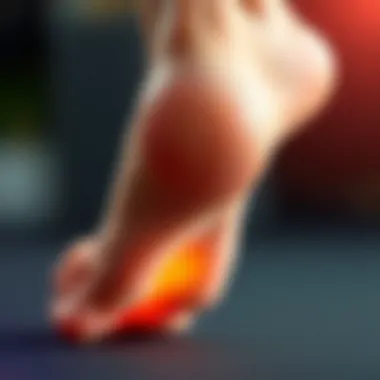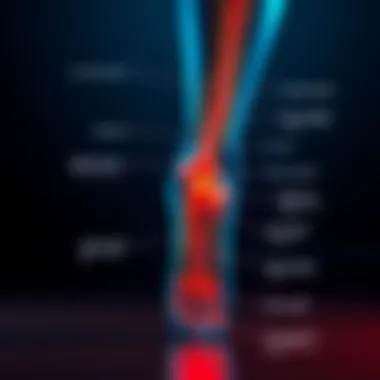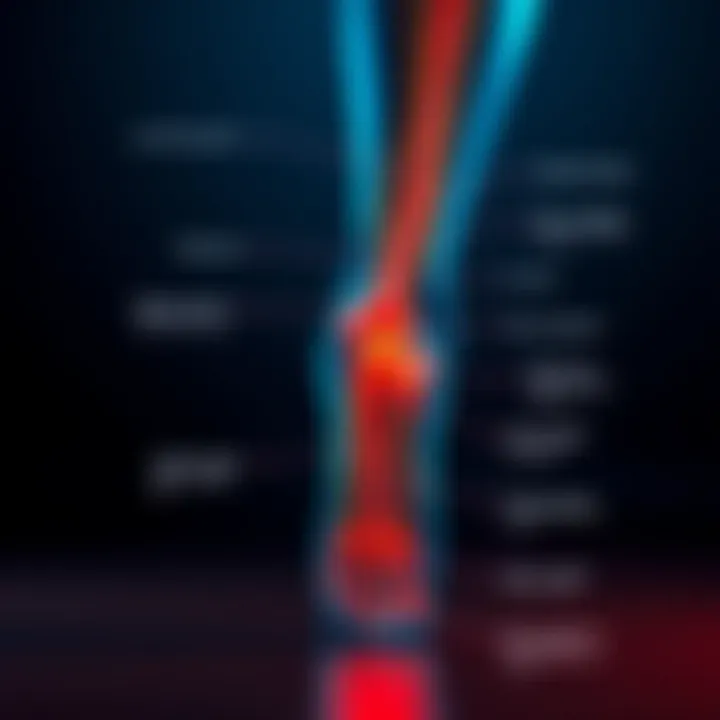Understanding the Causes of Tingling in the Feet


Intro
Tingling in the feet is a sensation that many experience at different points in their lives. This feeling, reminiscent of pins and needles, can range from a mild annoyance to a significant cause for concern. Understanding why this occurs is critical for countless individuals who, at one time or another, find themselves grappling with this phenomenon.
Several factors contribute to the tingling sensation in the feet. It can stem from various medical conditions, such as diabetes, neuropathy, or vitamin deficiencies, but it can also be influenced by lifestyle choices, like sitting too long or poor footwear selection.
By recognizing the significance and implications of foot tingling, it becomes easier for those affected to seek medical advice when needed, and to adopt practical management strategies that can alleviate discomfort. Knowing when a simple stretch might suffice and when it’s time to consult a healthcare professional can make a world of difference.
This article will dive into the multifaceted causes of foot tingling, presenting a thorough analysis of the neurological, vascular, and metabolic influences involved. Additionally, insights on diagnosis and management will be shared, offering comprehensive guidance for those searching for answers.
With a deeper understanding at hand, readers can take control of their health and well-being, making informed choices that enhance their quality of life.
Foreword to Feet Tingling
Tingling in the feet can be an unsettling sensation, often described using terms like "pins and needles" or that similar feeling one experiences after sitting in an awkward position. While many casually brush it off as something that will pass, understanding its causes is critical, especially if it becomes a regular occurrence. This article aims to shed light on the myriad of factors contributing to this sensation, leading to a more profound comprehension for both individuals and professionals in health-related fields.
This topic holds significant importance because tingling can be an early sign of multiple underlying health issues. It may range from benign conditions, like minor nerve compression, to serious disorders such as diabetes or circulatory problems. Ignoring persistent tingling could potentially lead to missed diagnoses or worsening health scenarios, therefore understanding the causes, symptoms, and implications is crucial.
Key Points of Discussion
- Neurological Factors: The world of nerves is intricate. Understanding how these pathways can misfire or become compromised offers substantial insight into the sensations experienced.
- Circulatory Health: Blood flow is vital for nerve function, and any interruptions can lead to tingling. Thus, recognizing circulatory problems expands our understanding of foot health.
- Metabolic Factors: Nutritional deficiencies can contribute significantly to nerve health. This article discusses the impact of various vitamins and metabolic disorders on the nervous system.
- Lifestyle Choices: Habits like prolonged sitting or repetitive physical activities often go overlooked. They can contribute directly to tingling, highlighting the importance of balanced lifestyles.
- Mental Health Connection: Anxiety and stress can manifest physically in various ways, including sensations like tingling. Understanding this connection bridges physical and psychological health.
Benefits of Gaining Insight
Gaining a comprehensive understanding of foot tingling leads to various benefits:
- Empowerment: Individuals become informed about their bodies, allowing for better self-advocacy in healthcare settings.
- Preventive Measures: Knowing potential causes can lead to lifestyles that prevent the onset of these sensations.
- Improved Interventions: For health professionals, having a clear picture enables better diagnosis and tailored interventions for clients.
Understanding Peripheral Neuropathy
Peripheral neuropathy is a significant player in the worrisome game of foot tingling. This condition involves damage to the peripheral nerves, which are crucial for sending signals between the brain, spinal cord, and the rest of the body. When these nerves falter, patients often experience a litany of symptoms that can disrupt day-to-day life. This section lays out the essential aspects of peripheral neuropathy and why grasping its nuances can be beneficial for those who encounter foot tingling.
Recognizing the defining features and mechanisms at play can empower individuals to seek the proper diagnosis and treatment. In our increasingly health-centric society, understanding such medical conditions not only aids in symptom management but may also illuminate underlying issues. Peripheral neuropathy may sneak in quietly, often mistaken for simple fatigue or stress. Hence, knowing the details can mean the difference between effective management and prolonged suffering.
Definition and Mechanisms
Peripheral neuropathy does not refer to a singular condition but rather a spectrum of disorders that stem from nerve damage. The most common culprit is diabetes, but factors such as trauma, alcohol consumption, exposure to toxins, and certain infections can also kick up trouble in the nerve department. When a nerve is damaged, it can misfire or stop working effectively.
There are three primary types of nerves that can be affected:
- Motor nerves: Control muscle movement.
- Sensory nerves: Allow the body to feel sensations such as temperature, pain, and touch.
- Autonomic nerves: Regulate involuntary functions like blood pressure and digestion.
As these nerves suffer, a range of distressing symptoms may emerge. The underlying mechanisms of peripheral neuropathy generally involve inflammation, reduced blood flow, or direct damage to nerve tissues. Not to mention, several medical conditions can lead to secondary types of neuropathy that masquerade under different symptoms while all leading back to nerve impairment.
Common Symptoms and Patterns
Foot tingling can emerge in various forms, painting a complicated picture that’s not a one-size-fits-all scenario. Symptoms can vary widely from one person to another, but common experiences include:
- Numbness or Reduced Sensation: Areas of the foot may feel less sensitive than normal.
- Burning Sensation: A fiery ache that can be quite distressing.
- Sharp Pain: Some might feel stabbing or shooting pains that disrupt movement.
- Tingling or “Pins and Needles”: A familiar sensation that can signal nerve irritation.
Recognizing patterns based on the distribution of these sensations can reveal much about their cause. For instance, symptoms often begin at the toes and may spread upwards. If tingling occurs in both feet simultaneously, it might suggest a systemic issue, while unilateral symptoms could indicate localized nerve injury.
"Peripheral neuropathy often starts with subtle symptoms but can escalate if neglected. Don’t ignore the nudging feeling in your feet."
By being attentive to these sensations, individuals may unlock a roadmap guiding them toward a proper diagnosis and treatment plan.
Further Reading and Resources
- Peripheral Neuropathy on Wikipedia
- National Institute of Neurological Disorders and Stroke
- American Academy of Neurology
- National Institute of Diabetes and Digestive and Kidney Diseases
Understanding and identifying peripheral neuropathy can enlighten those facing the unsettling sensation of tingling in their feet. By delving into the definition and mechanisms as well as recognizing common symptoms, individuals are better equipped to address underlying issues that do not just impact their feet but overall health.
Circulatory Causes of Tingling
When it comes to understanding tingling in the feet, it’s crucial to take a close look at circulatory causes. The circulation system plays such a vital role in our overall health that neglecting its influence on neurological symptoms can lead to significant oversight. Proper blood flow delivers essential nutrients and oxygen to tissues. Any disruption in this flow can result in sensations that might be categorized as tingling or numbness, which are often alarmingly misunderstood.
Peripheral Artery Disease
Peripheral artery disease, or PAD, is a condition marked by narrowed arteries reducing blood flow to your limbs, most frequently the legs. When the blood vessels become constricted, the legs and feet may feel unsupported, leading to that prickly sensation in the hands or feet. In many cases, individuals with PAD might experience cramping or fatigue in their legs. Sometimes, these symptoms emerge after physical activity, such as walking, making one reconsider what activities they can comfortably do.
If these sensations correspond with crossed legs or prolonged sitting, it might not be just the position causing discomfort. The reduction in blood flow due to PAD could very well be the main offender. Regular check-ups are essential since untreated PAD can heighten the risk of strokes or heart attacks, underscoring the importance of early detection of symptoms.
Blood Clots and Their Implications
Blood clots, they’re tricky little devils. A clot can obstruct blood flow, leading to heightened pressure and reduced sensation in the feet. The implications of these clots can range from mild discomfort to severe, potentially life-threatening conditions. For instance, Deep Vein Thrombosis (DVT) commonly occurs in the legs and can produce tingling sensations if it flows to the lungs or causes other systemic issues.
It is of utmost importance to recognize signs of potential clots, such as sudden warmth, swelling, or a leg that’s painful to the touch. If something feels off, trust your instincts. Always consult a medical professional, as prompt intervention can sidestep grave consequences, including pulmonary embolism.
"Ignoring signs can lead to severe health consequences. Stay aware of your body’s signals."
Diabetes and Circulatory Health
Diabetes directly impacts circulatory health, with high blood sugar levels leading to narrowing blood vessels over time. As a result, many diabetics experience reduced circulation, which manifests as tingling, especially in the extremities. This condition, known as diabetic neuropathy, can be misleading.
Interestingly, it’s not just the tingling sensation that one must remain mindful of, but also the potential for more severe complications like open sores or infections in the feet. Monitoring blood sugar levels diligently and refining one’s diet can be significant in reducing these alarming sensations and keeping circulation healthy.


To put it plainly, keeping glucose levels in check not only protects the body's internal organs but also fortifies the limbs, allowing individuals to steer clear of any undue discomfort in their feet. Those who have been diagnosed with diabetes should tread carefully, being mindful of the relationship between their glucose levels and foot sensations.
Metabolic Factors Behind Tingling
When it comes to tingling in the feet, metabolic factors can play an intricate role. The human body relies on a complex series of chemical processes to maintain its well-being. Nutritional deficiencies and hormonal imbalances can lead to various sensations in the extremities, including tingling. Understanding these factors is crucial not only for alleviating symptoms but also for maintaining overall health. A keen awareness of these metabolic influences can guide individuals towards making informed lifestyle changes that could alleviate discomfort.
Vitamin Deficiencies
Vitamin deficiencies can be a subtle yet impactful cause of tingling sensations in the feet. Vitamins, such as B12, D, and E are particularly important for nerve health.
- B12 is crucial for maintaining the myelin sheath, which protects nerve fibers. A lack of this vitamin can lead to neuropathy, which is often characterized by tingling. Sources of vitamin B12 include meat, fish, dairy, and fortified cereals.
- Vitamin D plays a role in calcium metabolism, which is fundamental for nerve function. Low levels of vitamin D can exacerbate feelings of numbness or tingling. Sunlight exposure and foods like fatty fish and fortified milk are vital sources of this vitamin.
- Vitamin E has antioxidant properties that assist in protecting nerve membranes. Inadequate levels can result in increased oxidative stress leading to nerve dysfunction.
"Nutritional balance isn't just good practice—it's a foundation for well-being."
It's essential to monitor these vitamin levels through dietary habits or supplements as needed. Particularly for those with certain dietary restrictions, making sure that your meals are well-rounded can keep those tingles at bay.
Hypothyroidism and Its Effects
Hypothyroidism, or an underactive thyroid, can significantly contribute to tingling sensations. The thyroid gland regulates a myriad of metabolic processes. When it doesn’t function properly, it can slow down how the body communicates at the nerve level. This can lead to symptoms such as:
- Nerve compression, which could explain the tingling in the extremities.
- Elevation of cholesterol levels, which could interfere with blood circulation.
- Fluid retention, causing swelling and pressure around nerves.
Individuals with hypothyroidism might also experience fatigue, weight gain, and depression, which could further complicate the perception of tingling due to altered physical sensations.
Regular monitoring and appropriate treatment can improve these symptoms significantly. Treatment often includes hormone replacement therapy to restore balance and maintain proper metabolic function. Lifestyle adjustments, such as a balanced diet and regular exercise, can also help manage symptoms effectively.
These metabolic aspects underscore the importance of looking beyond immediate symptoms. By addressing vitamin deficiencies and thyroid health, people can take practical steps towards alleviating tingling sensations in the feet while enhancing overall health.
Nerve Impingements and Injuries
Understanding the relationship between nerve impingements and injuries in the context of tingling in the feet is paramount. Often, these conditions are the culprits behind sensations that can range from mild discomfort to significant distress. Various injuries or impingements can lead to nerve compression, resulting in altered sensations, including tingling, numbness, or unusual warmth in the feet.
Addressing these issues not only helps in alleviating symptoms but also plays a vital role in preventing future complications. With the intricate network of nerves playing a vital role in everyday function, recognizing the signs early can lead to more effective management and treatment outcomes. Additionally, comprehending the underlying mechanics of these nerve conditions aids healthcare professionals in formulating a better approach to diagnosis and therapeutic interventions.
Sciatica and Lumbar Issues
Sciatica, characterized by pain radiating down the leg, often arises from an irritated sciatic nerve. This can occur due to herniated discs, bone spurs, or sometimes even muscle inflammation in the lower back region. The lumbar spine's intricate structure forms a critical area of support and mobility, and when issues arise here, the repercussions can affect other areas, notably the feet. Many patients report tingling sensations, numbness, or a feeling of weakness radiating to the foot due to sciatic nerve involvement.
It's crucial to note the connection of spinal health with foot function:
- Herniated Discs: When discs between vertebrae protrude, they may press against the roots of nerves, including those that branch off toward the legs and feet.
- Incorrect Posture: Bad posture can contribute to nerve compression in both the lumbar region and down the legs.
- Physical Activity: Certain activities might exacerbate these conditions, leading to recurring symptoms.
Understanding the relationship between lumbar issues and generalized pain, including tingling, a doctor might recommend physical therapy routes to relieve tension and improve mobility within the lumbar region. Ultimately, addressing lumbar health can lead to significant improvements in nerve function in the feet.
Tarsal Tunnel Syndrome
Tarsal Tunnel Syndrome is another pressing concern when discussing nerve impingements that lead to tingling sensations in the feet. This condition arises from compression of the posterior tibial nerve as it travels through the tarsal tunnel, a narrow space located on the inside of the ankle. Various factors can contribute to this condition, including swelling from arthritis, injury, or biomechanical issues such as flat feet.
The symptoms associated with Tarsal Tunnel Syndrome often manifest as:
- Persistent tingling within the arch and sole of the foot.
- Pain or sensitivity when pressure is applied to the arch area.
- A sense of numbness along with a burning sensation in some cases.
Practical steps to address Tarsal Tunnel Syndrome involve:
- Custom Orthotics: Soles specifically designed to support the arch can aid in redistributing weight and alleviating nerve pressure.
- Anti-Inflammatory Treatments: Medication to reduce inflammation around the nerve can provide relief.
- Surgical Options: In severe cases, decompression surgery might be considered to relieve pressure on the nerve itself.
By addressing these nerve-related injuries and impingements, patients can often experience not only relief from tingling but also improved overall mobility and foot function. A holistic approach, incorporating lifestyle changes and professional guidance, can notably enhance recovery and foot health.
Understanding the specific causes of tingling in the feet related to nerve issues is crucial. Early intervention can lead to better outcomes and quality of life.
For additional information on nerve injuries and musculoskeletal health, resources such as Mayo Clinic and Cleveland Clinic provide patient education and treatment options.
Infections and Inflammatory Conditions
Infections can trigger inflammatory responses that further complicate nerve pathways. When infections arise, the body mobilizes its defenses, resulting in swelling and discomfort, often affecting adjacent structures, including nerves. For anyone tracking their health, being aware of the signs and the underlying conditions fueling these symptoms can assist in timely intervention and management.
"One must delve deeper into irregular sensations like tingling to appreciate how infections interplay with our nerve systems."
Shingles and Its Neurological Impact
Shingles, caused by the reactivation of the varicella-zoster virus, can lead to significant neurological impacts including tingling in the feet. After a person contracts chickenpox, the virus doesn’t simply vanish; instead, it lies dormant in the nerve roots. Years later, stress, a weakened immune system, or other triggers can cause this dormant virus to reactivate, often leading to a painful rash.
The tingling sensation often precedes the appearance of the rash and is known as "pre-herpetic neuralgia." Patients frequently describe this experience as a prickle or itch, often localized but can radiate outward, complicating the overall sensation. Additionally, if the virus affects certain nerve roots, it can lead to long-lasting pain and discomfort even after the rash resolves, ultimately impacting the patient's quality of life. Identifying shigles early can help in managing symptoms more effectively, lowering the intensity and duration of these nerve-related sensations.
Lyme Disease's Role in Nerve Symptoms
Lyme disease is another infection worth mentioning regarding tingling sensations. Transmitted through tick bites, this condition can manifest various symptoms, ranging from fatigue to complicated joint issues. Of considerable interest, though, is how Lyme disease affects the nervous system, leading to tingling and numbness, particularly in the extremities.
The spirochete bacteria responsible for Lyme disease can invade the nervous system, leading to neuroborreliosis. Symptoms can include burning or tingling sensations similar to those reported in peripheral neuropathy. Emerging evidence suggests that early detection of Lyme disease from tick bites and subsequent treatment markedly decreases the chances of long-term neurological complications. As symptoms evolve, the resultant tingling in one's feet may serve as a warning flag that demands medical attention.
In sum, infections and inflammatory conditions serve as significant factors contributing to tingling in the feet. By understanding their role, practitioners can better educate clients on preventative measures, conditions to watch for, and how to engage effectively with their healthcare providers. With the right knowledge, managing these symptoms is more within reach.
The Role of Anxiety and Stress
Anxiety and stress, often brushed aside as mere manifestations of our hectic lives, can profoundly impact our physical well-being. While most discussions about anxiety focus on emotional outcomes, the physiological responses can lead to significant sensations such as tingling in the feet. This section emphasizes the importance of recognizing anxiety and stress as potential contributors to foot tingling, providing insights into how mental state directly influences physical sensation.
When a person experiences anxiety, the body tends to enter a fight-or-flight response. This evolutionary mechanism prepares individuals to deal with immediate threats, yet it can have side effects that are less desirable in modern life. Increased levels of adrenaline lead to heightened awareness but also to muscle tension and altered blood flow, which can cause sensations like tingling. It's crucial to understand that these psychosomatic responses are not just in one's head; they can translate into very real physical experiences, including those annoying tingling feelings in the extremities.


Key considerations regarding anxiety and stress include:
- Recognizing Symptoms: It's essential for individuals, especially health professionals, to observe that emotional distress can create tangible reactions in the body.
- Management Techniques: Implementing practices such as mindfulness, yoga, and simple breathing exercises may alleviate not just mental stress but also those unsettling physical sensations.
- Interconnectedness of Mind and Body: Understanding that mental and physical health are intertwined can empower sufferers to take comprehensive approaches to their well-being.
"Anxiety doesn’t just wear you down mentally; it can manifest its toll physically, often in ways surprising to the unsuspecting individual."
Psychosomatic Responses
The term psychosomatic refers to a condition where psychological factors can lead to physiological symptoms. For many, the experience of tingling in the feet may be a psychosomatic response to stress or anxiety. By simply thinking about stressors—be it at work, personal issues, or health concerns—the body can react as though it’s under threat. Blood circulation may alter, and with it, nerve responses may become exaggerated.
Often overlooked, psychosomatic responses remind us that emotional experiences have a ripple effect on our bodily functions. For example:
- Increased Heart Rate: Anxiety may lead to a pounding heart, which can disrupt normal blood flow to the legs and feet.
- Muscle Tension: Tension can constrict blood vessels, making the extremities feel cold or tingly.
- Distracted Awareness: The more one is focused on anxiety, the less they might be in tune with their physical sensations, often attributing them to something else entirely.
Panic Attacks and Physical Sensations
Panic attacks can be sudden and overwhelming, often characterized by an intense feeling of dread accompanied by physical symptoms. Among these symptoms, tingling – especially in the hands and feet – may occur. This happens due to rapid breathing (hyperventilation), where the body expels too much carbon dioxide, causing changes in blood pH and leading to what many call a "pins and needles" sensation.
Here’s why understanding panic attacks is vital:
- Speed of Onset: Unlike chronic anxiety, panic attacks can strike unexpectedly, making their effects feel even more alarming.
- Cognitive Effects: During a panic attack, thoughts can spiral, further amplifying sensations like tingling, leading individuals to feel as though something is seriously wrong.
- Path to Recovery: Recognizing panic attacks as a serious health concern can inform treatment approaches, from psychological counseling to lifestyle adjustments.
In summary, recognizing the role of anxiety and stress can significantly alter how one perceives and addresses the tingling sensations in their feet. This understanding opens pathways to more effective management and treatment, emphasizing the importance of addressing both mental and physical health holistically.
Lifestyle Contributions to Tingling
Exploring how lifestyle choices affect the sensations in our feet opens a door to understanding the broader context of health. Habitual patterns can significantly influence nerve health and circulation, thus leading to tingling sensations. In this section, we will focus on two primary contributors: sedentary behavior and repetitive motions related to occupation.
Sedentary Behavior
The modern world often encourages a lifestyle where we find ourselves sitting for prolonged periods, whether at work, in front of screens, or during leisure activities. This sedentary nature can significantly impair circulation.
When blood flow is restricted, it can lead to a sense of numbing or tingling in the feet. The longer someone remains in one position, the more likely they will experience these sensations. This doesn't just impact individuals with desk jobs; anyone who engages in extended periods of inactivity may be at risk.
To tackle this issue, incorporating regular movement throughout the day is essential. Here are some strategies:
- Stand and Stretch: Take breaks every hour to stand up and stretch.
- Walking Meetings: If possible, conduct meetings while walking.
- Foot Exercises: Simple exercises while seated can enhance circulation, such as flexing and pointing the toes.
Quality of life can shoot up with these changes, providing a protective layer against the discomfort of tingling in the feet.
Repetitive Motions and Occupation
On the flip side, certain occupations involve repetitive motions that can lead to nerve compression or irritation in the feet. For instance, those who stand for long periods, like retail workers or healthcare professionals, may find their feet under constant stress. This strain can create a chronic condition where the nerves become compromised, triggering sensations of tingling.
Consider the following key points related to repeated actions:
- Footwear Matters: Wearing supportive and well-fitted shoes can make a world of difference. Poor footwear exacerbates the risk.
- Proper Technique: Learning to maintain correct posture and foot position during activities can prevent undue strain on the nerves.
- Workplace Ergonomics: Optimize your workspace to reduce strain. Using mats for standing jobs or choosing appropriate seating for sedentary roles can be particularly beneficial.
The cumulative effect of these lifestyle habits can’t be underestimated. Being proactive about one’s routines offers a tangible way to mitigate potentially uncomfortable sensations in the feet. By recognizing how everyday choices can impact health, individuals can make informed decisions that lead to better overall wellbeing.
"A stitch in time saves nine"—addressing these minor lifestyle contributions promptly can prevent larger issues down the road.
When to Seek Medical Attention
Tingling in the feet can often feel like an annoying itch you just can’t scratch. It can range from mild and fleeting sensations to persistent and bothersome feelings, prompting many individuals to ponder whether a visit to a healthcare provider is warranted. Knowing when to seek medical attention is crucial, not only for your peace of mind but also for addressing any underlying health concerns.
Understanding the spectrum of symptoms associated with foot tingling assists in recognizing warning signs. Some causes may be benign, like sitting in one position too long, while others may signal a more serious condition necessitating medical intervention.
Identifying Warning Signs
Certain scenarios should act as red flags, prompting immediate medical assistance. If tingling is accompanied by subtle but consistent pain, weakness in the legs, or a sensation of heaviness in the feet, these could indicate a more severe issue, such as nerve damage or vascular problems. Other signs include:
- Sudden onset: This could suggest a stroke or transient ischemic attack (TIA) if tingling occurs suddenly and is accompanied by facial drooping or speech difficulties.
- Persistent symptoms: If tingling lasts for more than a few days despite changing positions or improving circulation, it's time to consult a healthcare professional.
- Bilateral symptoms: Tingling affecting both feet can suggest systemic issues such as diabetes or multiple sclerosis that require further investigation.
"Ignoring persistent tingling could lead to longer-term complications if there’s an underlying condition. Better safe than sorry!"
Recognizing these warning signs early through regular self-assessment can lead to prompt treatment and potentially prevent complications which may arise from untreated conditions.
Possible Diagnostic Procedures
Upon deciding to seek medical attention, your healthcare provider might suggest various diagnostic procedures to pinpoint the cause of the tingling.
Electromyography
Electromyography (EMG) measures the electrical activity of muscles at rest and during contraction. It's a vital tool used in diagnosing nerve and muscle disorders. One of its key characteristics is its ability to detect abnormal electrical activity in muscles, which could indicate neuropathies due to conditions like diabetes. EMG is popular in this discussion as it uniquely illustrates how nerves and muscles are communicating—or not communicating—properly. However, it does have its downsides; some patients might feel discomfort from the needle insertions, making it less preferable for those with a lower tolerance for pain.
Blood Tests
Blood tests are another essential diagnostic technique. The key aspect of blood tests is their ability to reveal underlying metabolic issues, such as vitamin deficiencies or thyroid irregularities, which can manifest as tingling. They’re beneficial because they can provide a quick overview of your body’s state of health through just a vial of blood. However, they may miss localized nerve issues since blood tests primarily reveal systemic conditions, requiring further tests for complete diagnostic clarity.
Imaging Studies
Imaging studies like MRI or CT scans help visualize the spine, brain, and blood vessels, identifying any structural abnormalities or lesions that may be compressing nerves and causing tingling sensations. The significant feature here is the ability to see the physical structures that might contribute to neurological symptoms. Their advantage lies in their non-invasive nature and the detailed images they provide. On the downside, imaging studies can sometimes uncover incidental findings that may not be related to the patient’s symptoms, leading to unnecessary anxiety and further tests.
All these diagnostic procedures serve different yet complementary purposes. They can provide a thorough understanding of the mechanisms behind the tingling and guide appropriate treatment plans.
Treatment and Management Strategies


The sensation of tingling in the feet can range from a mild annoyance to a disruptive experience that affects daily life. Understanding the proper modes of treatment and management is paramount for reducing symptoms and improving quality of life. It’s essential for individuals experiencing these sensations to explore their options and choose suitable approaches tailored to their specific needs. This section will dissect both coping mechanisms for mild symptoms and several medical interventions, offering a comprehensive view of each method's practicalities, benefits, and potential drawbacks.
Coping Mechanisms for Mild Symptoms
For many, tingling is not chronic but instead happens intermittently, often triggered by positions that strain nerves or compress blood vessels. Coping with these mild symptoms starts with easy and effective strategies that can be practiced at home. Here are a few suggestions:
- Change Positions Periodically: Shift your position regularly to lessen nerve compression. For instance, if sitting for long periods, experiment with varying your leg position or standing up to stretch.
- Foot Elevation: Elevating the feet can help increase blood circulation, potentially reducing tingling sensations. Simple adjustments, such as propping your feet up on a cushion, can make a difference.
- Gentle Massage: Massaging the feet can promote blood flow and ease muscle tension. Consider using lotion or oil for a soothing effect.
- Warm Compress: Applying a warm compress to the feet can relax tense muscles. Avoid hot water that could lead to burns, instead use a mild, warm cloth.
- Nerve Stretching Exercises: Deliberately stretching the feet and legs may improve nerve function and reduce tingling. Simple stretches can often be integrated into daily routines.
Medical Interventions
When home remedies don’t suffice, medical interventions may be necessary. These interventions range from medications to physical therapy and, in certain cases, surgical procedures. Below, we explore each option in detail:
Medications
Medications often provide relief for those suffering from persistent tingling due to underlying conditions. They may target specific causes, such as nerve damage or inflammation. Common types include:
- Pain Relievers: Over-the-counter options like ibuprofen or naproxen can minimize discomfort.
- Antidepressants: Certain antidepressants, like amitriptyline, can assist in neuropathic pain relief, providing dual benefits for mood and pain.
- Anti-seizure Medications: Gabapentin is typically recommended for nerve pain, effectively reducing abnormal nerve signals.
The key feature of medications is their ability to address specific symptoms effectively and swiftly. However, one must pay attention to potential side effects, as some individuals might experience fatigue, nausea, or other complications. Always consult professionals before starting any new medication to weigh the pros and cons carefully.
Physical Therapy
Physical therapy plays a crucial role in managing foot tingling, especially when nerve compression or injuries are involved. A trained physical therapist can devise an individualized treatment plan including:
- Strengthening Exercises: Targeted exercises can fortify the muscles supporting the feet, thereby alleviating pressure on nerves.
- Postural Adjustments: Physical therapists can help with identifying and correcting poor posture and body mechanics that may lead to repeated nerve strain.
The distinctive advantage of physical therapy lies in its holistic approach, addressing not just symptoms but also underlying issues. Patients often find lasting relief and improved mobility through these tailored exercises. Nevertheless, finding the right therapist is key, as results heavily hinge on the quality of guidance received.
Surgery Considerations
In more severe cases, surgical intervention may become necessary—mainly when physical therapy and medications fail to alleviate symptoms. Surgical options usually aim to relieve nerve compression, such as in carpal tunnel syndrome or tarsal tunnel syndrome cases. Key considerations include:
- Restoration of Nerve Function: Surgery can lead to significant improvements by directly addressing the root cause, often resulting in diminished or eliminated symptoms.
- Recovery Time: Post-operative recovery can vary significantly, meaning patience is necessary as healing progresses.
Surgery can be a last resort, presenting benefits alongside inherent risks such as infection or failed outcomes. It’s imperative to discuss all options thoroughly with a specialized surgeon who understands foot ailments intimately.
A thorough examination and a customized approach can considerably enhance the quality of life for those grappling with tingling in their feet.
In summary, both coping mechanisms for mild symptoms and various medical interventions exist to tackle the tingling sensations in feet. Understanding these options enables individuals to choose the best path forward, fostering better health and well-being.
Preventive Measures for Healthy Feet
Maintaining the health of our feet often slips down the priority list in our busy lives. However, preventive measures are essential not just for comfort but also for overall health. The feet support the weight of the body and play a significant role in mobility. Neglecting foot health can lead to discomfort, chronic infections, or even debilitating conditions. In this section, we'll dig into some practical strategies to keep your feet in tip-top shape, emphasizing the connection between preventive care and proactive well-being.
Regular Exercise and Foot Health
When it comes to taking care of your feet, exercise is a cornerstone. Engaging in regular physical activity can enhance blood circulation and strengthen muscles in the lower extremities, which helps in maintaining nerve health. Incorporating foot-specific exercises, such as stretching and strengthening routines, can aid in both muscle balance and flexibility, ultimately reducing the risk of injuries.
- Examples of beneficial exercises:
- Toe raises or calf stretches can promote flexibility and strength.
- Foot rolls using a tennis or lacrosse ball to relieve tension.
- Balance exercises like standing on one foot to improve proprioception.
These practices not only fortify the feet but also contribute to greater overall agility and stability.
"Just like a solid foundation supports a strong house, healthy feet keep our whole body steady and active."
Engaging in at least 30 minutes of moderate aerobic activity most days can significantly improve foot health. Activities like walking, swimming, or cycling boost circulation and keep the nerves firing on all cylinders, which is essential in preventing tingling sensations. Vigorous movement also helps maintain a healthy weight, reducing unnecessary stress on the feet.
Balanced Nutrition for Nerve Support
Another integral piece of the foot health puzzle is nutrition. What you consume plays a vital role in nerve function and overall metabolic health. A balanced diet rich in vitamins and minerals can help support not just your feet but your entire nervous system. Here are key nutrients to consider:
- Vitamin B12: Essential for nerve health, a deficiency can lead to tingling and numbness. Sources include meats, fish, dairy, and fortified cereals.
- Magnesium: Works wonders for muscle function. Found in nuts, seeds, whole grains, and leafy greens.
- Omega-3 fatty acids: Help reduce inflammation and support overall nerve health. Sources include fatty fish like salmon, walnuts, and flaxseeds.
Incorporate these nutrients into your meals consistently. For example, a salmon salad topped with avocado and nuts can be a tasty way to boost both nerve health and overall nutrition.
For more information on foot health and preventive measures, consider checking resources at NIH or visiting CDC for health wellness tips.
The Connection Between Feet and Overall Health
Understanding the connection between feet and overall health is crucial, especially in the context of the tingling sensations discussed. Feet are not merely endpoints of our limbs; rather, they serve as ground zero for numerous health indicators. From diabetes and peripheral neuropathy to signs of circulatory issues, our feet can tell us a lot about what’s happening within our bodies. This section aims to shed light on how symptoms in the feet can reflect systemic health concerns, opening a new lens through which we view bodily well-being.
How Foot Symptoms Reflect Systemic Issues
When we observe symptoms such as tingling, numbness, or pain in our feet, it is vital to recognize that these sensations are often not isolated events. Instead, they may signal broader health issues. Here are some points to consider:
- Nerve Health Connection: Tingling may indicate issues like peripheral neuropathy, often linked with diabetes. Over time, high blood sugar levels can damage nerve fibers, leading to those unwanted sensations.
- Circulatory Signals: Poor blood flow can cause tingling in the feet. Conditions like peripheral artery disease may restrict blood from reaching the feet, manifesting as a tingling sensation, which alerts us to potential circulatory problems.
- Vitamin and Mineral Deficiencies: A lack of essential nutrients such as Vitamin B12 can lead to nerve damage and consequently, trigger tingling. This highlights the importance of a balanced diet in maintaining overall nerve health.
- Musculoskeletal Issues: Conditions like sciatica can impact the nerves serving the feet, translating into symptoms like tingling or numbness. This shows that spinal health directly influences foot sensations.
- Hormonal Influences: Women may experience foot symptoms during pregnancy related to hormonal changes, impacting fluid retention or nerve compression, illustrating a link between foot health and hormonal balance.
Highlighted here is the intricate web connecting our feet to the rest of our body's systems. Symptoms we might brush aside could be warnings that shouldn��’t go ignored. Being attentive to what our feet are trying to communicate can not only help in early diagnosis but can also foster a proactive approach to overall health management.
"Our feet are like the proverbial canary in the coal mine. They alert us to underlying health issues before they escalate."
Closure and Key Takeaways
As we wrap up the examination of tingling in the feet, it's clear that this phenomenon is not merely an innocent annoyance. The sensations, while sometimes trivialized, can be indicators of underlying issues that warrant careful attention. Whether stemming from neurological conditions, circulatory problems, or lifestyle choices, the causes of tingling are as diverse as they are significant. Understanding these intricacies not only aids in effective management but also empowers individuals to make informed health decisions.
Key Points to Consider
- Severity and Duration: The tingling can be a fleeting experience or persist for longer periods. If it lasts, it might be wise to consider medical consultation. Ignoring it could lead to overlooking serious conditions.
- Symptoms Beyond Tingling: Often, tingling is coupled with other sensations such as numbness, weakness, or pain. It's crucial to evaluate the complete picture rather than focus solely on the tingling.
- Holistic Health Perspective: The connection between feet and overall health is profound. Symptoms in the feet often reflect broader systemic issues relating to metabolic health, nutritional status, or circulatory efficiency.
- Lifestyle Adjustments: Simple changes can make a world of difference. From incorporating regular exercise to ensuring a balanced diet rich in essential nutrients, proactive measures can alleviate some instances of foot tingling.
- When to Seek Help: Knowing when to call in the professionals can be the difference between early intervention and compounded health issues. Certain red flags include sudden onset tingling post-injury, persistent sensations after prolonged sedentary habits, or the inclusion of other, more alarming symptoms.
Knowledge is power. By remaining informed about potential causes and recognizing when to seek treatment, individuals can enhance their overall quality of life.
The information presented throughout this article aims to illuminate not just the symptoms but also the multifaceted dimensions of foot tingling. This understanding is imperative for health professionals, wellness coaches, and anyone invested in holistic health practices. By weaving together insights from medical, lifestyle, and nutritional aspects, we can foster an environment where informed choices flourish.















